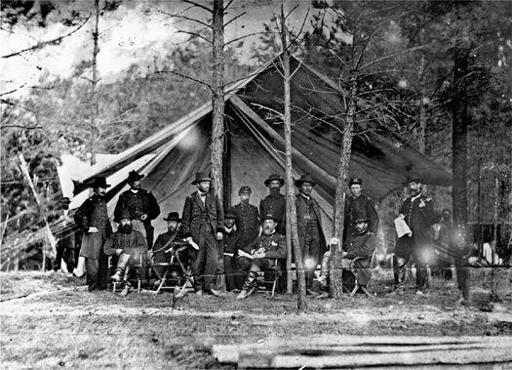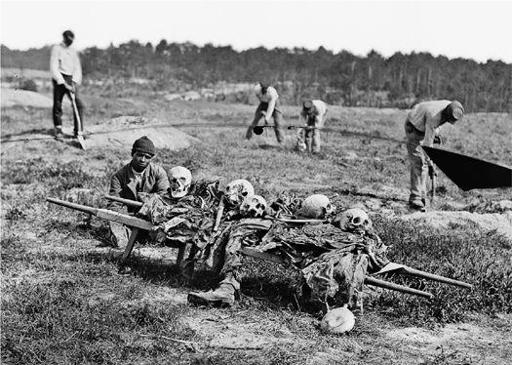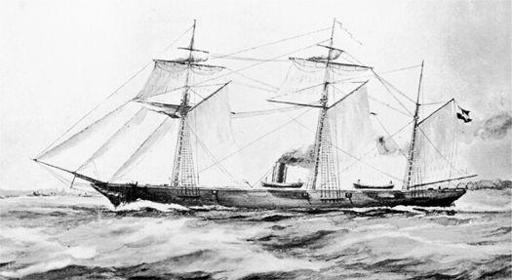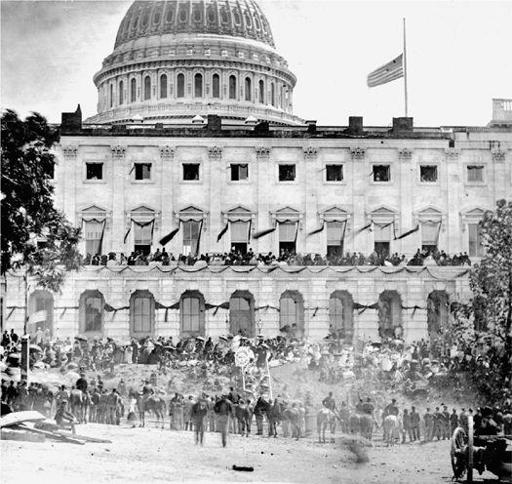A World on Fire: Britain's Crucial Role in the American Civil War (149 page)
Read A World on Fire: Britain's Crucial Role in the American Civil War Online
Authors: Amanda Foreman
Tags: #Europe, #International Relations, #Modern, #General, #United States, #Great Britain, #Public Opinion, #Political Science, #Civil War Period (1850-1877), #19th Century, #History
72.
A Federal observation balloon.

73.
U.S. Lieutenant General Ulysses S. Grant (1822–85), center, whose victories in the Western theater of the Civil War led to President Lincoln appointing him general-in-chief in March 1864. Grant was relentless in war and magnanimous in victory.

74.
Battle of Cold Harbor, May 31–June 3, 1864. The fourth phase of U.S. General Grant’s campaign against Confederate General Lee ended in defeat for the Union. Grant was labeled “Butcher Grant” because of the high number of Federal casualties. The fighting took place over the same area as the Battle of Chancellorsville in 1863, and soldiers could not help treading on human remains.

75.
CSS Alabama. In twenty-two months the Confederate commerce raider covered more than 75,000 miles, captured or sank sixty-five Northern merchant ships, destroyed $5 million worth of Northern goods, and caused a massive sell-off of U.S. merchant marine.

76.
CSS Stonewall. A Confederate ironclad ram, she was commissioned by James Bulloch in England and built in France, though delays prevented her from reaching the South before the end of the war.

77.
The crew of USS Kearsarge. The sloop-of-war, commanded by Captain John Winslow, defeated CSS Alabama in an extraordinary duel in the English Channel on June 19, 1864.

78.
Fort Sedgwick, the bomb-proof Union quarters at Petersburg, called “Fort Hell” by its occupants. Opposite was Fort Mahone, known as “Fort Damnation.” The siege of Petersburg cost the lives of 70,000 in nineteen separate battles.

79.
The trenches of Petersburg. Between June 1864 and April 1865 the two armies were spread out in a maze of trenches stretching more than thirty miles. “All day long,” wrote a British observer, “the men sat in their fetid dugouts, sweltering in the heat, until the night shift relieved them.… Soldiers talked about fearful slaughtering they had witnessed in vague tones, as if they wished to forget it.”

80.
Charleston at the end of the war. Charleston was regarded with special hatred by Union forces because it was here that the war began on April 12, 1861, when Confederate General Beauregard fired on the Federal-held Fort Sumter, forcing its surrender. “If there is any city deserving of holocaustic infamy, it is Charleston,” declared the New York Herald Tribune.

81.
Richmond after its fall on April 3, 1865. Fire threatened to engulf the entire city and the Federal invaders became firefighters, saving what they could. Fifty-five blocks, the entire business district, went up in flames.

